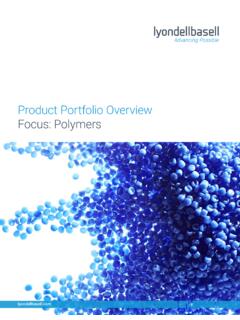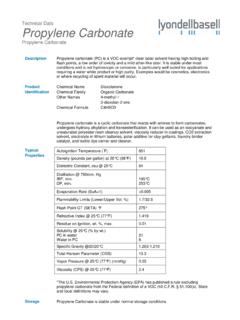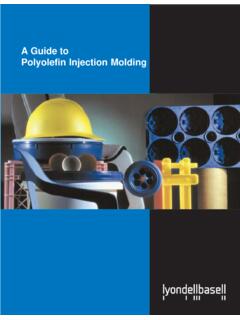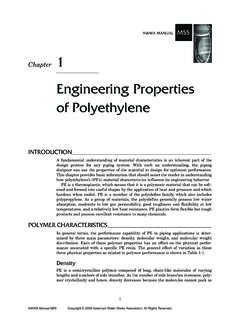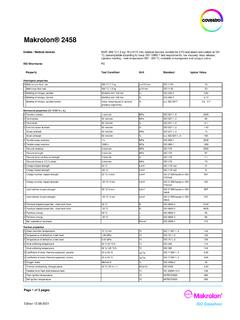Transcription of A Guide to Polyolefin Film Extrusion - LyondellBasell
1 Guide to Polyolefin Film ExtrusionAbout UsLyondellBasell is one of the world s largest plastics, chemical and refining companies. We are the largest producer of polypropylene and polypropylene compounds; a leading producer of propylene oxide, polyethylene, ethylene and propylene; a global leader in polyolefins technology; and a producer of refined products, including products and technologies are used to make items that improve the quality of life for people around the world including packaging, electronics, automotive components, home furnishings, construction materials and of ContentsiiAbout Us iTable of Contents iiIntroduction 1 Polyolefins are Thermoplastics Derived from Petrochemicals 2 Molecular Structure and Composition Affect Properties and Processability 3 Density 4 Molecular Weight 5 melt Viscosity 5 Molecular Weight Distribution 5 Comonomers 5 Modifiers, Additives and Tie Layers 6 LyondellBasell Works Closely with Processors 6 Shipping and Handling Polyolefin Film Extrusion Resins 6 How Polyolefins are Made 7 LDPE 7 HDPE 8 LLDPE 8 PP 8 The Film Extrusion Process 9 Materials Conditioning/Handling 9 Materials Handling Equipment Design 9 Blending with Colorants and Additives 10 Film Extrusion Equipment 11 Extruder 11 Coextrusion Systems 12 Cascade Extrusion Systems 12 Hopper 13 Barrel 13 Heaters 14 Thermocouples 14 Screw 14 Mixing Screws 15 Barrier-Type Screws 15 Screen Pack and Breaker Plate 15 Automatic Screen Changers 16 Pressure Valves 17 Adapter 17 melt Pumps 17 Film Forming Equipment 18 Die 18 Transfer Piping/Adapters 18 Blown Film Dies 19 Rotating Dies 19 Automatic Gauge Adjustment 19 Coextrusion Blown Film Dies 20 Cast Film Dies 20 Coextrusion Cast Film Dies Coextrusion Feedblock 21 Coextrusion Cast Film Dies 21
2 Cooling Systems 22 Blown Film Cooling 22 External Air Rings 22 Internal Bubble Cooling 22 Bubble Stabilizer 23 Cast Film Cooling 23 Takeoff and Windup Equipment 24 Blown Film Tower 24 Guide Bars 24 Collapsing Frames 24 Nip Rolls 24 Width Measurement 24 Gauge Measurement 24 Oscillating Haul-Off Units 25 Surface Treaters 25 Guide Rolls 25 Feed Roll Assembly 24 Optical Inspection System 25 Film Winders 25 Surface Winders 25 Center Winders 26 Surface/Center Assist Winders 26 Gap Winding 26 Taper Tensioning 26 Automatic Roll Changers 26 Turret Winders 26 Web Slitters 26 Edge Cutting System 26 Recycling Systems 27 Controls 27 Operation of a Blown Film Line 28 Start-Up Procedure for Film Line 28 Accident Prevention 28 Shutdown Procedures for Blown Film Extruders 29 Cleaning the Extruder and Its Parts 30 How to Clean the Extruder 30 Cleaning the Screw 30 Cleaning the Barrel 30 Cleaning the Adapter 30 Cleaning the Breaker Plate 30 Cleaning the Blown Film Die 30 Cleaning the Cast Film Die 30 Optimizing Film Extrusion Process 31 Flat Film Forming 31 Temperatures 31 Screw Speed 31 Gauge Control 31 Width 31 Cooling 31 Tubular Film Forming 31 Temperatures 31 Screw Speed 31 Blow-up Ratio 32 Cooling 32 Process Variables Controlling Property Improvement 33 Barrier 33 Clarity 33 Environmental Stress Crack Resistance 33 Gauge Uniformity 33 Gloss 33 Heat Sealability 33 Stiffness 33 Strength 33 Toughness 33 Slip 33 Shrink Wrap and Stretch Wrap 33 Appendix 1: Metric Conversion Guide 34 Appendix 2: Abbreviations 36 Appendix 3: ASTM Test Methods Applicable to Film Extrusion 37 Appendix 4: Trade Names for Products of LyondellBasell Chemicals 38 IntroductionPolyolefins that can be extruded as monolayer and multilayer film include.
3 Low density polyethylene (LDPE) Linear low density polyethylene (LLDPE) High density polyethylene (HDPE) Ethylene copolymers, such as ethylene vinyl acetate (EVA) and ethylene methyl acrylate (EMA) Polypropylene, propylene copolymers (PP) and thermoplastic olefins (TPOs).In general, the advantages gained with Polyolefin films are ease of processing, light weight, good toughness and tear resistance, flexibility (even at low temperatures), outstanding chemical resistance and relatively low cost compared with other plastics. The basic properties of polyolefins can be modified with 1 Polyolefins are the most widely used plastics for film Extrusion . A Guide To Polyolefin Film Extrusion contains general information concerning materials, methods and equipment for producing high quality Polyolefin film products at optimum production broad range of chemical modifiers. Further, Polyolefin -based films can be coextruded with various other polymers, including ethylene vinyl alcohol (EVOH), nylon, polyester barrier resins and adhesive tielayers, to produce multilayer films with special, high-performance properties.
4 Major application areas for Polyolefin films are: Packaging for food, textiles, consumer products, industrial products, medical products, merchandise, among others Agriculture Construction Consumer products, including diaper backing, garment bags, household wrap and trash bags Materials handling, including stretch wrap and shrink wrapLLDPE filmPolyolefin films are used in a wide variety of filmLDPE filmThis manual contains extensive information on Polyolefin film Extrusion ; however, it makes no specific recommendations for the processing of LyondellBasell Chemicals resins for specific applications. For more detailed information, please contact your LyondellBasell polyethylene sales AreThermoplastics DerivedFrom PetrochemicalsPolyolefins are plastic resins polymerized from petroleum-based gases. The two principal gases are ethylene and propylene. 2 Ethylene is the principal raw material for making polyethylene (PE) and ethylene copolymer resins; and propylene is the main ingredient for making polypropylene (PP) and propylene copolymer resins.
5 Polyolefin resins are classified as thermoplastics, which means that they can be melted, solidified and melted again. This contrasts with thermoset resins which, once molded, cannot be Polyolefin resins for film Extrusion generally are used in pellet form. The pellets are about 1/8 inch thick and 3/16 inch in diameter, usually somewhat translucent and white in color. Polyolefin resins sometimes will contain additives, such as thermal stabilizers. They also can be compounded with colorants, antistatic agents, slip and antiblockMolecular Structure and Composition Affect Properties and ProcessabilityThree basic molecular properties affect most of the properties essential to high quality film Extrusion : Average Molecular Weight Molecular Weight Distribution Crystallinity or molecular properties are determined by the materials used to produce the polyolefins and the conditions under which they are manufactured. The basic building blocks for the gases from which polyolefins are derived are hydrogen and carbon atoms.
6 For polyethylenes, these atoms are combined to form the ethylene monomer, C2H4, , two carbon atoms and four hydrogen atoms (see Figure 1). In the polymerization process, the double bond connecting the carbon atoms is broken. Under the right conditions, these bonds reform with other ethylene molecules to form long molecular chains (Figure 2). The resulting product is polypropylene, the hydrogen and carbon atoms are combined to form the propylene monomer, CH3CH=CH2, which has three carbon atoms and six hydrogen atoms (Figure 3). The third carbon atom remains pendant and protrudes from the spiraling backbone copolymers, such as EVA and EMA, are made by the polymerization of ethylene units with randomly distributed comonomer groups, such as vinyl acetate (VA) and methyl acrylate (MA).The polymerization of monomers creates a mixture of molecular chains of varying lengths. Some are short, while others 3are enormously long, containing several hundred thousand monomer units.
7 For polyethylene, the ethylene chains have numerous side branches. For every 100 ethylene units in the molecular chain, there are about one to 10 short or long branches. The branches radiate in three dimensions (Figure 4).Chain branching affects many polymer properties including density, hardness, flexibility and transparency, to name a few. Chain branches also become points in the molecular network where oxidation may occur. In some processing techniques where high temperatures are reached, oxidation can adversely affect the polymer s 1: Ethylene monomer molecular structureFigure 2: Polyethylene molecular 3: Polyethylene chain with side 4: Polyethylene chain with side resins have a mixture of crystalline and amorphous areas. Molecular chains in crystalline areas are arranged somewhat parallel to each other. In amorphous areas, they are randomly arranged. This mixture of crystalline and amorphous regions (Figure 5) is essential to the formation of good film products.
8 A totally amorphous Polyolefin would be rubber-like and have poor physical properties; a totally crystalline polymer would be very hard and homopolymer polyethylenes, the higher the resin density, the higher the degree of crystallinity. High density PE resins have molecular chains with comparatively few side chain branches. This allows the chains to pack more closely together. The result is crystallinity up to 85%. Low density PE resins generally have crystallinity from 35 to 55%. Linear low density PE resins have crystallinity from 35 to 60%. Polypropylene resins are highly crystalline, but they are not very LLDPE resins densities range from to grams per cubic centimeter (g/cc) LDPE resins range from to g/cc MDPE (medium density) resins range from g/cc HDPE resins range from to g/cc PP resins range from to g/cc The densities of EVA and EMA copolymers are functions of the proportion of comonomer incorporated into the resin; as comonomer increases, density increases, but crystallinity density, in turn, influences numerous properties (Table 1).
9 With increasing density, some properties increase. However, increased density also results in a reduction of some properties, , stress cracking resistance and low temperature 5: Crystalline (A) and amorphous (B) regions in 1: General Guide to the Effects of LDPE Resin Physical Properties on their Mechanical Properties and melt index IncreasesAs Density IncreasesChemical Resistance Remains Same IncreasesClarityIncreasesIncreasesElonga tion at Rupture DecreasesDecreasesExtrusion Speed (faster solidification)Remains SameIncreasesFilm DrawdownIncreasesIncreasesFilm Impact Strength (toughness)DecreasesDecreasesFlexibility DecreasesRemains SameGlossIncreasesRemains SameHeat Resistance (softening point)DecreasesIncreasesImpermeability to Gases/LiquidsRemains SameIncreasesLow Temperature FlexibiityDecreasesDecreasesMelt ViscosityDecreasesIncreasesMechanical Flex LifeDecreasesDecreasesResistance to Film BlockingDecreasesIncreasesStress Cracking ResistanceDecreasesDecreasesTensile Strength at RuptureDecreasesIncreasesMolecular WeightMolecular Weight Atoms of different elements, such as carbon, hydrogen, etc.
10 , have different atomic weights. For carbon, the atomic weight is 12, and for hydrogen it is 1. Thus, the molecular weight of the ethylene unit is the sum of the weight of its six atoms (2 carbon + 4 hydrogen) or Polyolefin resin consists of a mixture of large and small chains, , chains of high and low molecular weights. The molecular weight of the polymer chain generally is in the thousands. The average of these is called, quite appropriately, the average molecular average molecular weight increases, resin toughness increases. The same holds true for tensile strength and environmental stress cracking resistance (cracking brought on when film is subjected to stresses in the presence of liquids such as solvents, oils, detergents, etc.). melt ViscosityMelt viscosity generally is expressed for polyethylene resins by their melt indices (tested under standard conditions of temperature and pressure). melt index (MI) is inversely related to the resin s average molecular weight: as average molecular weight increases, MI decreases.

